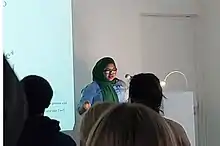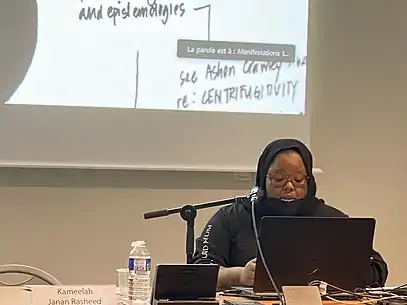Kameelah Janan Rasheed
Kameelah Janan Rasheed (born 1985) is an American writer, educator, and artist from East Palo Alto, California.[1][2] She is a 2021 Guggenheim Fellow in Fine Arts known for her work in installations, book arts, immersive text-based installations, large-scale public text pieces, publications, collage, and audio recordings.[3] Rasheed's art explores memory, ritual, discursive regimes, historiography, and archival practices through the use of fragments and historical residue.[4] Based in Brooklyn, NY, she is currently the Arts Editor for SPOOK magazine. In 2021 her work was featured in an Art 21 (New York Close Up) documentary, "The Edge of Legibility."
Kameelah Janan Rasheed | |
|---|---|
 Kameela Janan Rasheed giving a talk in the Jacob Lawrence Gallery at the University of Washington in Seattle. | |
| Born | 1985 East Palo Alto, California |
| Nationality | American |
| Alma mater | Stanford University (Ed.M) |
| Known for | Contemporary Art, Writing, Education |
| Notable work | How to Suffer Politely (And Other Etiquette), No Instructions for Assembly |
| Website | www |

Background
Early life
Born in East Palo Alto, California to Sunni Muslim parents,[5] Rasheed characterizes herself as "a Muslim kid enrolled at a Catholic school and attended Mormon school dances, who went to shabbat dinners and attended Sunday church services with friends."[5] When Rasheed was twelve years old, her family was unlawfully evicted from their home due to the sharp increase of land value in northern California near East Palo Alto,[6] and entered a period of homelessness that lasted for the next ten years. The experience of moving through temporary homes with her family led to an interest in the practice of collecting and archiving to cope with her forced displacement.[7]
Rasheed attended Pomona College for her undergraduate degree, studying public policy and Africana.[8] She traces her interest in visual art to class on black aesthetics and the politics of representation taken in her penultimate semester at Pomona. She was awarded an Amy Biehl Fulbright Scholarship to study in South Africa. Returning to the U.S., she completed a graduate degree in secondary education from Stanford University. Early in her career, Rasheed taught social studies from the elementary school to high school level. Her background in history and pedagogy influences her artistic practice.
Visual art
Rasheed came to photography and collaging while living and studying in South Africa as an exchange student, and later as a Fulbright Scholar, where she discovered an interest in the act of documentation and interviewing. The first iteration of her immersive installation, No Instructions for Assembly, Activation I (2013), took place at Real Art Ways and consisted of over six hundred objects, including found and personal family photos, album covers, tufts of family members' hair, Islamic prayer rugs, newspaper clippings, jewelry, prayer beads, black stockings, and mirrors, among other items. Subsequent iterations of the installation have invited audiences to modify and contribute their own objects and histories to her growing archive.[6][9]
Themes
The major themes of Rasheed's work revolve around conflicting histories, visual culture, being black in America, unearthing buried narratives, and the complexity of memory.[6] Her art engages with her background in history and education, turning exhibitions into pedagogical experiences and opportunities to explore archives, our personal relationship with history, and public spaces.[8]
Rasheed's art has used distinctive signs with large, capitalized font in public spaces arranged in series or a grid. For instance, How to Suffer Politely (And Other Etiquette) is a series of billboard-size yellow posters with all-black font announcing slogans like "LOWER THE PITCH OF YOUR SUFFERING" or "TELL YOUR STRUGGLE WITH TRIUMPHANT HUMOR".[8] The work engages with the Black Lives Matter movement, noting how people were told not to react with anger to police killing people of color in America, but also with etiquette guides from the 1800s. Similarly, Art After Trump is a political abecedarius with all-capitalized lines spelling out phrases like "SUPERLATIVE SUBJUGATION" and "PIGMENTED PRIVILEGE".[10]
Education
Rasheed holds an M.A. in Secondary Education from Stanford University and received a B.A. in 2006 from Pomona College in Public Policy and Africana Studies.[11]
Awards and fellowships
Rasheed has been the recipient of numerous grants, fellowships, and residencies, including:[12]
2022
2021
2016
- Artist-in-residence, Bronx Museum of Art Co-Lab Residency | New York, NY[13]
- Artist-in-residence, Creative Exchange Lab - Portland Institute of Contemporary Art | Portland, OR
- Artist-in-residence, Smack Mellon | Brooklyn, NY
- Artist-in-residence, The Center for Afrofuturist Studies at Public Space One | Iowa City, IA
- Copy Shop Resident, Endless Editions at Robert Blackburn Printmaking Workshop | New York, NY
- Shortlisted, Visionary Award from the Tim Hetherington Trust | New York, NY
- Fellow, Ossian Fellowship - Jain Family Institute | New York, NY
2015
- Artist-in-residence, Lower East Side Print Shop | New York, NY
- Commissioned Artist/Scholar in Residence, Triple Canopy at New York Public Library Labs | New York, NY
- Grantee, Artadia: The Fund for Art and Dialogue | New York, NY
- Fellow, Artist Fellowship, AIR Gallery | Brooklyn, NY
- Fellow, Queens Museum – Jerome Foundation Fellowship Program, Queens Museum | Queens, NY
- Fellow, Artist in the Marketplace (AIM 35), Bronx Museum | Bronx, NY
2014
- Grantee, Art Matters Foundation | New York, NY
- Grantee, Rema Hort Mann Foundation Emerging Artist Grant | New York, NY
- Artist-in-residence, Working Classrooms | Albuquerque, NM
- Artist-in-residence, Vermont Studio Center | Johnson, VT
2013
- Fellow (Create Change Professional Development), The Laundromat Project | New York, NY
- Juror, Center for Photography at Woodstock A-I-R | Woodstock, NY
- Artist-in-residence, Center for Book Arts | New York, NY
- Artist-in-residence, Visual Artist Network - Real Art Ways | Hartford, CT
- Grantee, Visual Artist Network Community Fund - Real Art Ways | Hartford, CT
2012
- Awardee, STEP UP - Real Arts Ways | Hartford, CT
- Artist-in-residence, Center for Photography at Woodstock | Woodstock, New York
2006
- United States Fulbright Amy S. Biehl Scholar, U.S. Department of State | Johannesburg, South Africa
2005
- Harry S Truman Scholar, U.S. Department of State | Washington, D.C.
- Fellow, Rockefeller Brothers Fund | New York, NY
Published Writing
As a writer, Rasheed has published an array of essays and interviews, including:[12]
- No New Theories 2019
- "Black deaths matter: victims' humanity, not perfection, are the reason to mourn." The Guardian. February 12, 2016
- "Public Empathy Must Not Be Reserved Only for 'Perfect Victims'." Creative Time Reports. February 12, 2016
- “Carceral State: An Interview with Eric A. Stanley.” The New Inquiry. November 3, 2014
- “On Loneliness: A Reading List.” Longreads. August 16, 2014
- “Black Lives Worthy of Elaboration: A Conversation with Rachel Kaadzi Ghansah.” Gawker. June 7, 2014
- “A Conversation with Roxane Gay.” Specter Magazine. May 2, 2014
- “A Conversation with Daniel José Older.” Specter Magazine. April 2, 2014
- "All Things Considered": An Interview with Kiese Laymon.” Specter Magazine. December 2, 2013
- “’Beautifully Disturbing’: An Interview with Wendy C. Ortiz.” Specter Magazine. November 2, 2013
- “’Here's to the Weird": An Interview with Victor LaValle.’” Specter Magazine. September 2, 2013
- “A Vessel for Peace: An Interview with Writer Ocean Vuong.” Well & Often Press. February 2, 2013
Selected exhibitions
Kameelah Janan Rasheed's work has been featured in exhibitions at galleries and institutions including solo shows at:
- A.I.R. Gallery, Brooklyn, USA On Refusal (2016)[14]
Rasheed's work, Tell Your Struggle with Triumphant Humor, 2014 is included in the Exhibition For Freedoms, conceived as an artist-run super PAC,[15] which is inspired by inspired by a speech by Franklin Roosevelt's 1941 Four Freedoms speech.[16][17]
For Whisper or Shout: Artists in the Social Sphere, at BRIC House in Brooklyn in 2016, Rasheed showed a reconstruction of a childhood living room as part of the ongoing project her ongoing project No Instructions for Assembly.[18][19]
References
[20][21][22][23][24][25][26][27][28][29][30][31][32][33][34]
- "Kameelah Janan Rasheed". 2016. Retrieved 2017-03-10.
- "Muslim Artist Denied Flight by US Airport Security - artnet News". artnet News. 2015-11-26. Retrieved 2017-03-10.
- "Statement - Kameelah Janan Rasheed". www.kameelahr.com. Retrieved 2017-03-12.
- "Kameelah Janan Rasheed - Lower Manhattan Cultural Council". Lower Manhattan Cultural Council. Retrieved 2017-03-12.
- Gore, Sydney (2016-02-21). "Kameelah Janan Rasheed Explores Her Curiosities Through The Visual Arts". Nylon. Retrieved 2017-03-12.
- "The Archives of Kameelah Rasheed". Art21 Magazine. 15 April 2015. Retrieved 2017-03-12.
- "Artist Interview: Kameelah Janan Rasheed of Everything is Index, Nothing is History | Recession Art". recessionartshows.com. Retrieved 2017-03-12.
- Roach, Imani (2017-03-06). "Kameelah Rasheed: Who Will Survive in America?". Guernica Magazine. Retrieved 2018-03-15.
- "Kameelah Rasheed - No Instructions for Assembly, Activation VII". Vox Populi. Archived from the original on April 12, 2016. Retrieved July 6, 2022.
- "Art After Trump: An Alphabetical Arrangement". Hyperallergic. 2016-12-23. Retrieved 2018-03-16.
- "Kameelah Janan Rasheed". Smack Mellon. March 2016. Retrieved 8 March 2017.
- "CV - Kameelah Janan Rasheed". www.kameelahr.com. Retrieved 2017-03-12.
- "Open Studio with BxMA Co-Lab Dance Resident Jasmine Hearn and Visual Artist Kameelah Rasheed - Event - The Bronx Museum of the Arts". The Bronx Museum of the Arts. Retrieved 2017-03-12.
- Rodney, Seph (18 May 2016). "A Black American Artist Explores Her Refusal of Christianity". Hyperallergic. Hyperallergic Media Inc. Retrieved 8 March 2017.
- Kaplan, Isaac (2016-06-09). "Can an Artist-Run Super PAC Be More Than a Gimmick?". Artsy. Retrieved 2017-03-08.
- "Unconventional Super PAC Mixes Art and Politics". WNYC. 2016-07-15.
- "Exhibition". For Freedoms. Archived from the original on 2017-03-12. Retrieved 2017-03-09.
- Cotter, Holland (2016-04-21). "Galleries Scramble Amid Brooklyn's Gentrification". The New York Times. ISSN 0362-4331. Retrieved 2017-03-08.
- "BRIC announces "Whisper or Shout" Exhibition". BRIC. 16 February 2016. Retrieved 9 March 2017.
- "Enter an Immersive Environment Crafted out of Black History - Creators". Creators. Retrieved 2017-03-08.
- "10 Black Artists to Watch in 2016 - artnet News". artnet News. 2016-02-13. Retrieved 2017-03-08.
- Schwendener, Martha (2016-01-07). "At the Studio Museum in Harlem, 4 Shows Engage a Cultural Conversation". The New York Times. ISSN 0362-4331. Retrieved 2017-03-08.
- "20 Emerging Female Artists -artnet News". artnet News. 2015-12-09. Retrieved 2017-03-08.
- "Art of work: Exhibit tackles income inequality". Brooklyn Paper. Retrieved 2017-03-08.
- "New Park Slope art exhibit explores income inequality | Brooklyn Daily Eagle". www.brooklyneagle.com. 14 August 2015. Retrieved 2017-03-08.
- Ilnytzky, Ula (2015-08-21). "Nonprofit group fills empty New York spaces with art". Christian Science Monitor. ISSN 0882-7729. Retrieved 2017-03-08.
- "Articles | ArtSlant". www.artslant.com. Retrieved 2017-03-08.
- "Kameelah Janan Rasheed: 5 Must-Read Interviews With Young Black Writers". Clutch Magazine. Retrieved 2017-03-08.
- "Articles | ArtSlant". www.artslant.com. Retrieved 2017-03-08.
- "If You Build It in Harlem". Hyperallergic. 2014-07-30. Retrieved 2017-03-08.
- Cotter, Holland (2014-07-10). "'If You Build It,' a Local Show Celebrating Local Art". The New York Times. ISSN 0362-4331. Retrieved 2017-03-08.
- "art:i:curate // "If you build it" celebrates Harlem Art and Community". www.articurate.net. Retrieved 2017-03-08.
- Dawson, Jessica (2014-06-25). "No Longer Empty's 'If You Build It' Opens at Harlem's Sugar Hill". Wall Street Journal. ISSN 0099-9660. Retrieved 2017-03-08.
- "Other Histories: An Interview with Kameelah Janan Rasheed « Paper Journal". paper-journal.com. 20 June 2013. Retrieved 2017-03-08.